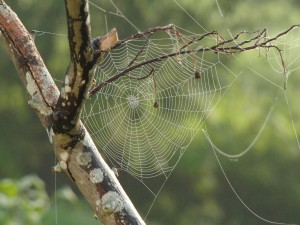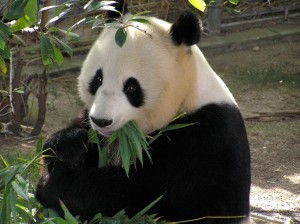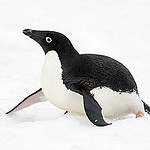
Teaching a fly to fear
The fruit fly Drosophila is one of the key model species in science. Away from the safety of the lab, there are few more terrifying sights for a wild adult female Drosophila than a parasitic wasp. While these wasps are no threat to the adult fly itself, they present grave danger to her offspring.
Up to 90% of wild Drosophila larvae are parasitized by these wasps, who use them as hosts for their own offspring. Unsurprisingly then, female Drosophila have a strong in-built response to the sight of these wasps, including a significant reduction in egg-laying (better to save the eggs for a safer place).
Rather more surprisingly, new research shows that female flies can teach each other about the presence of wasps. Female flies kept in laboratory enclosures with parasitic wasps showed the expected reduction in egg-laying, a behaviour which continues for several days after removal of the wasps. If these flies are then moved to wasp-free enclosures alongside ‘naïve’ female flies, who have themselves not encountered wasps, these naive females reduce their own rate of egg-laying.
This suggests a kind of social learning; the naive flies anticipate the presence of parasitic wasps based on the behaviour of the ‘teacher’ flies. Clearly, even ‘simple’ animals are capable of learning from one another.
Oh, what a tangled web we weave

Fellow slovenly readers will be all too aware of the miracles of biological engineering that inhabit the ceilings of our houses – spiders’ webs. Spider silk itself is famously a stronger material by weight than steel, and now new research examines the strategies that spiders take to optimize the construction of their webs.
One consideration that spiders face is that constructing a web takes a lot of energy, so it pays to optimize the amount of silk in each thread. For small garden spiders, constructing their web is a daily task; those tropical spiders that make giant webs repair them for a few days before replacing them, so the webs consequently have to resist the elements.
The new study takes two approaches to studying web construction: firstly computational modelling of the mechanical response and damage tolerance of web designs, and secondly testing 3D-printed replica webs in silicone material, varying the thickness of the radial spoke threads and the sticky spiral thread.
The researchers found that there are different optimum thicknesses of the strands depending on the kind of forces the web faces. For daily webs, where the impact of the spider’s dinner crashing into the web is its biggest stress, radial and spiral threads with similar thicknesses are optimal. However for giant webs that may face days of wind and rain, thicker radial threads with lightweight spiral threads are a better solution.
Zhao Qin et al,. Nature Communications
Fins ain’t what they used to be
The design of some features of living organisms has evolved again and again, independently in distantly related organisms. Familiar examples of this ‘convergent evolution’ are animal flight using wings and vision using a camera-type eye.
This is thought to suggest that within the limitations of living organisms, the laws of physics mean that there are only a small number of useful designs, so the evolution of different organisms will independently converge upon them.
Another example, examined in a new study, is median/paired fin swimming – that is, the kind used by fish such as rays and knifefish, and invertebrates such as cuttlefish and flatworms that have elongated fins the length of their bodies, and which propel themselves by sending undulating waves down these fins.
The study found that among these diverse organisms one feature was optimized: the wavelength of fin movement for maximum thrust. This had evolved in eight separate groups of organisms. Although not the most powerful form of swimming, these creatures are all adapted for environments where small, precise and efficient swimming motions are required.
Rahul Bale et al., PLoS Biology
It’s hard to digest how a panda eats so much bamboo

The giant panda is an unusual bear for many reasons. One is its diet; while most other bears are omnivores, giant pandas feed exclusively on bamboo. Yet they are poorly adapted to this herbivorous diet and have to eat huge quantities of bamboo to obtain sufficient nutrients.
This necessitates a very large habitat; one of the reasons giant pandas are at such risk of extinction. It now appears that one reason behind this inefficient bamboo digestion is that the panda’s gut microbiota is too much like that of its omnivorous relatives.
Gut microbes were sequenced from a large number of faecal samples taken from adult and juvenile pandas across several populations and seasons. The results show that giant pandas have a low diversity of bacteria in their gut, typical of omnivorous bears but quite different from that of other herbivores.
In particular they have very low levels of cellulose digesting bacteria. It is generally thought that having a high diversity of gut microbiota is beneficial for host health, allowing resilience to environmental stresses. This suggests that the low bacterial diversity in panda guts is another reason why their lifestyle seems such a fragile one.
Too much ice is bad news for birds
We have all read about the impact on wildlife of melting Arctic sea ice; images spring to mind of polar bears struggling through the sea, trying to find sufficient ice on which to hunt. However on the other side of the world, in the Antarctic, climate change is having the opposite effect; sea ice is increasing in extent.
Sadly, this may be as damaging for Antarctic wildlife as melting ice is in the Arctic. New research suggests the increase in sea ice is having a significant impact on many sea birds. Populations in this region have been monitored by scientists for over 50 years, meaning we know the ‘normal’ amount of chicks different species produce each year.

Many species have seen substantial declines in recent years. For example, Adélie penguin populations typically rear 15,000-30,000 chicks a year; in 2014 not a single chick survived the breeding season.
Researchers suggest that increasing sea ice is forcing parents to travel further to reach the open water they feed in. This both increases the energy cost of foraging to the parents and reduces the regularity of feeding for the chicks, seemingly a deadly combination. Whether at the North or South pole it seems the changes being driven by climate change pose a severe threat to the survival of many species.
Barbraud et al., Royal Society Open Science
Comments